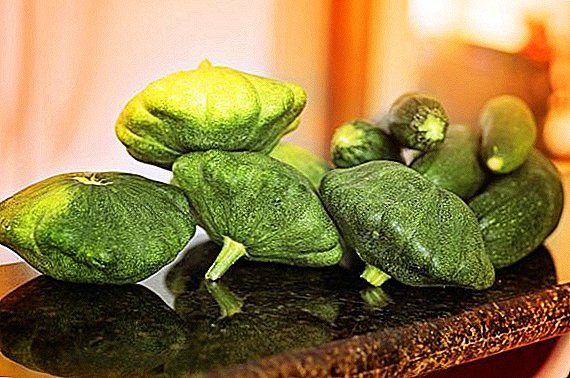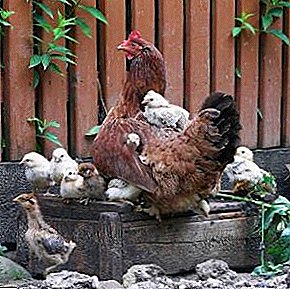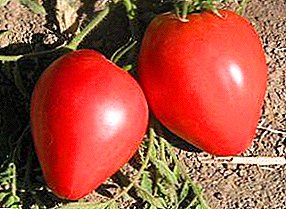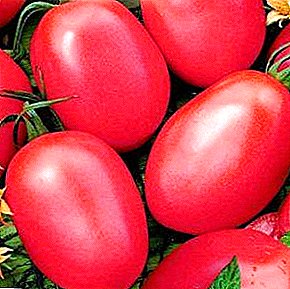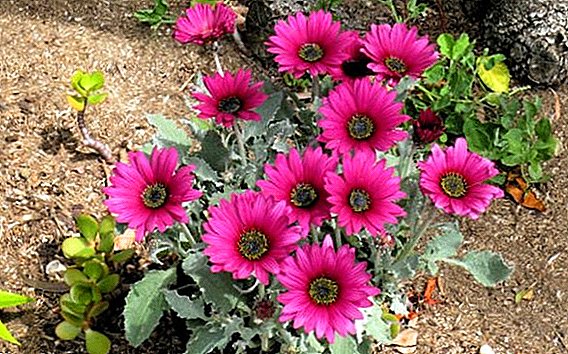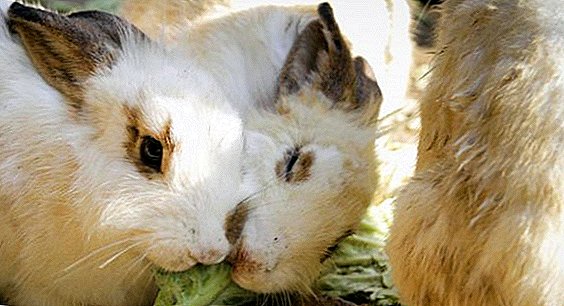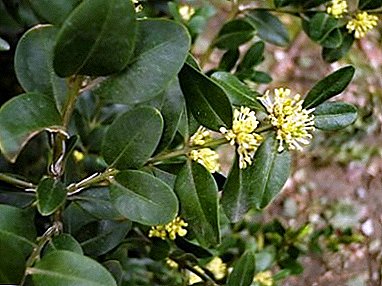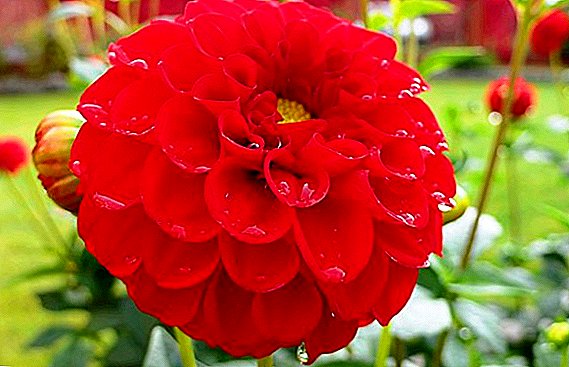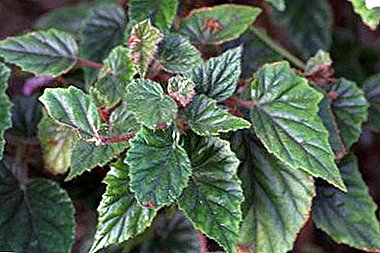
Metallic begonia (telesnootnaya or metallic) is a representative of the decorative and foliage kind. The culture is unpretentious, it does not require a lot of light.
In order for the plant to become a real decoration of the interior and to be pleased with a lush flowering, it must be properly maintained, protected from diseases and pests.
Further we will tell in detail about this plant: what it looks like, what are its features. A detailed look at planting, breeding and care.
Botanical description and origin
Metallic begonia (Begonia Metallica) got this name because of the peculiar color of the leaves: on the reverse side they are purple, and on the front greenish-olive color. Red streaks with a metallic sheen. Culture grows very large. Its height often reaches 1 meter. The leaves are large, 15 cm in length. Stem pubescent and branching.
Telescolor begonia originally from Brazil. Habitat - wet, darkened hills in pine and deciduous forests at an altitude of 800-1700 meters above sea level.
Appearance, features and photos of the flower
The leaves of the metal begonia are long, asymmetrical, oval with jagged edges. Leaf plate pubescent.
 Plant features:
Plant features:
- fluffy flowers saturated pink color;
- reddish stem;
- on the stalks there are both female and male flowers;
- growing all year round; active periods: spring and summer;
- the fruit is a triangular box that forms above the petals of female flowers.
Flowering begonia metallic abundantly. Due to its large size it is used to decorate a room, a greenhouse, singly or in combination with other varieties of begonias.
Landing
- Lighting and location.
Culture prefers diffuse lighting and partial shade, tolerates blackout. The leaves are very sensitive to direct sunlight - burns appear on them. The lack of light will reduce the variegation of foliage and adversely affect the development of the flower.
Important! Metal begonia does not tolerate high humidity and drafts.
Balcony for growing a flower is not suitable, because it does not tolerate strong temperature drops. The western, eastern or northern side of the room will be the ideal place to keep.
- The soil.
Begonias are planted in a nutrient, loose and slightly acidic soil. To prepare a quality substrate, mixed in equal proportions:
- sand;
- sod land;
- humus;
- peat;
- leaf ground.
For the planting of young plants use a softer soil: mixed equally sandy, leafy soil and peat.
- Features landing.
Deciduous begonias are planted in early spring, when it begins to grow. The pot is chosen deep and wide, preferably plastic. From it it is easy to extract the plant during transplantation. To ensure air access to the roots and outflow of excess water, drainage holes are made in the tank.
Drainage must be laid on the bottom: small pebbles or expanded clay. The flower may perish from excessive moisture.
The seedling is placed in a pot and sprinkled with cooked soil.
How to care for a houseplant?
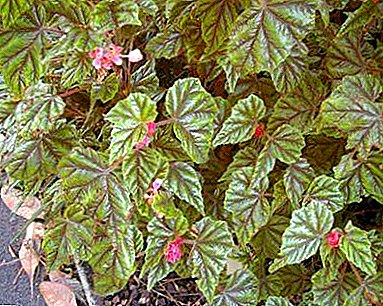 Temperature and humidity.
Temperature and humidity.Metallic begonia does not tolerate sharp drops. The optimum temperature is from +16 to 25 degrees. In winter, at least + 15-16 degrees. Culture loves high humidity, but does not tolerate moisture on the leaves. To ensure the required level of moisture, the flower is placed on a pallet with wet pebbles or expanded clay.
- Watering.
For the begonia of the telescolour is not acceptable stagnant moisture. The root system will start to rot. Drying the ground is also not acceptable.
Watering features:
- Systematic and moderate moisture as the soil dries. When it dries to 1.5 cm - the plant requires moisture.
- Use only warm and soft water, pre-boiled and settled.
- Water can be slightly acidified with lemon.
- In the fall and spring to limit moisture.
Note! Can not be used for irrigation cold water from the tap.If in winter it is impossible to keep the temperature in the room above +15 degrees, the flower is watered with warm water and additionally installed warmer water near the tray. The top layer of earth is loosened by 1 cm.
- Top dressing.
Fertilize begonia with organic and mineral compounds, alternating them every two weeks. You can buy universal fertilizers for decorative leafy plants or special for begonias.
- The specifics of care.
Once a year in the spring of deciduous culture transplanted into a more spacious pot. In a small pot, metal begonias begin to fade. After transplantation, pruning is performed. Old and long stems cut off, leaving a small stump. Leaves and cuttings allowed to root.
Diseases and pests
Growing problems and diseases
Due to non-compliance with the rules of plant care can get sick. The result of excessive bays and too high temperature in the room at the begonia begins to rot the stem at the base, the leaves fall down. To get rid of the problem, watering reduce and carry the plant pot in a cool place.
If water drops accidentally fall on the leaves, and it is under the direct sun, burns occur on the leaf plates. The flower is immediately removed into the shaded area. When the air is too dry, the edges of the leaves dry out and turn brown. With a lack of light, the sheets become pale and shallow, elongated.
Metal begonia affects various diseases:
 Fungus. A gray mold appears on the stem, leaves and flowers due to the increased air humidity. Treatment: improve ventilation in the room, avoiding drafts. The plant is treated with a fungicide.
Fungus. A gray mold appears on the stem, leaves and flowers due to the increased air humidity. Treatment: improve ventilation in the room, avoiding drafts. The plant is treated with a fungicide.- Mealy dew. Leaves are covered with gray bloom, curled and died. The disease causes increased humidity at a temperature of plus 20-24 degrees. To cure begonia, it is allowed to dry, improve air circulation and apply fungicides.
- Viral infection. Yellow spots appear on the sheets. The disease is not treated. The plant should be destroyed to protect other flowers from infection.
On a note. Begonia should not be placed in the kitchen near the gas stove. It is very sensitive to gas combustion products. Because of this, the plant becomes lethargic and drooping.
Herb culture will be restored if it is provided with ideal conditions for keeping: put in a well-lit place, reduce watering. If in winter the leaves become discolored, it means that there are drafts in the room or it is not warm enough. The plant is transferred to a warm place.
Pests
- In the summer of begonia can attack aphid. The leaves turn yellow, curl and fall off along with the buds. To fight against insects, the plant is sprayed with Actellik and Fufanon.
- Under high humidity conditions, the greenhouse whitefly appears. Signs: the leaves were discolored and began to dry. To get rid of the pest using a soap solution.
- Abundant watering in too warm conditions provoke the emergence of a spider mite. The marble color of the leaves, yellowing and the appearance of cobwebs testify to the defeat. The drug Decis will help solve the problem.
Breeding
Metal begonia is bred in different ways: cuttings, leaves (parts of leaves), seeds and division of the bushes.
Cutting:
- From the stems cut off the shoots of 8-10 cm in length.
- Immersed in water.
- When the roots appear, planting material is placed in a pot with a substrate.
- The vessel is covered with plastic wrap.
- When leaves appear (after 6 weeks), the cuttings are transplanted into a larger container.
Leaf:
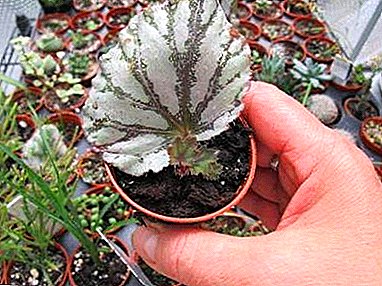 To multiply the begonia leaf, it is cut and placed in water.
To multiply the begonia leaf, it is cut and placed in water.- After the appearance of the roots, the leaf stalk is planted in a container with the substrate.
Begonia seeds are planted in January or early February. Algorithm:
- Planting material is disinfected in potassium permanganate and placed in a moistened soil.
- Capacity with seeds covered with glass or plastic film.
- Before the emergence of shoots container kept in a warm, well-lit place.
- For airing lift glass or film.
- When the seeds germinate, they are put in a cool place.
- When the third leaf appears, the seedlings dive.
The division:
- To divide the begonia bush, rhizome is taken out of the pot, cleaned from large leaves, washed.
- The bush is divided into two parts with a sharp knife.
- The slices are treated with coal powder.
- The resulting planting material is placed in a container with the substrate.
Growing begonia telesnotsvetnoj at home will not be easy. The culture is unpretentious in care: prefers moderate watering; bright, well protected from direct sunlight.


 Temperature and humidity.
Temperature and humidity. Fungus. A gray mold appears on the stem, leaves and flowers due to the increased air humidity. Treatment: improve ventilation in the room, avoiding drafts. The plant is treated with a fungicide.
Fungus. A gray mold appears on the stem, leaves and flowers due to the increased air humidity. Treatment: improve ventilation in the room, avoiding drafts. The plant is treated with a fungicide. To multiply the begonia leaf, it is cut and placed in water.
To multiply the begonia leaf, it is cut and placed in water.